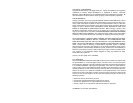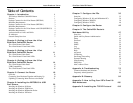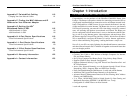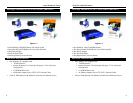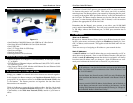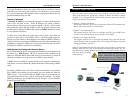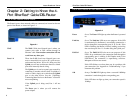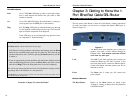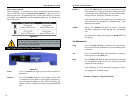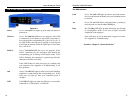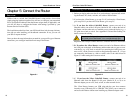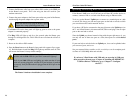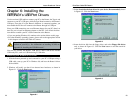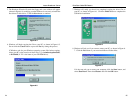
EtherFast
®
Cable/DSL Routers
The Router’s firewall (NAT) protects your network of PCs so users on the pub-
lic, Internet side cannot “see” your PCs. This is how your LAN, or network,
remains private. The Router protects your network by inspecting the first pack-
et coming in through the WAN port before delivery to the final destination on
the LAN port. The Router inspects Internet port services like the web server,
ftp server, or other Internet applications, and, if allowed, it will forward the
packet to the appropriate PC on the LAN side.
Remember that the Router’s ports connect to two sides: your 10/100 LAN
port(s) and the Internet WA N port. The LAN port(s) transmit data at 10 Mbps
or 100 Mbps, whereas the broadband port, or WAN port, transmits data at
10 Mbps.
What’s an IP Address?
IP stands for Internet Protocol. Every device on an IP-based network, includ-
ing PCs, print servers, and routers, requires an IP address to identify its “loca-
tion,” or address, on the network. This applies to both the WAN and LAN con-
nections.
There are two ways of assigning an IP address to your network devices.
Static IP Addresses
A static IP address is a fixed IP address that you assign manually to a PC or
other device on the network. Since a static IP address remains valid until you
disable it, static IP addressing ensures that the device assigned it will always
have that same IP address until you change it. Static IP addresses are com-
monly used with network devices such as server PCs or print servers.
5
Instant Broadband
™
Series
4
• One EtherFast Cable/DSL Router with USB Port & 3-Port Switch
• One Setup Wizard CD-ROM with User Guide Included
• One USB Cable
• One 3.5" Floppy Disk for USB Setup
• One Power Adapter
• One Fast Start Guide
• One Registration Card (not shown)
• Internet Explorer 4.0 or Higher (5.5 Recommended), or Netscape Navigator
4.7 or Higher
• TCP/IP Protocol, Ethernet Adapter, and Ethernet Cable (UTP CAT 5 with RJ-
45 connectors) per PC
• One External Cable or DSL Modem with Ethernet Port and Ethernet Cable
(UTP CAT 5 with RJ-45 connectors)
Simply put, a router is a network device that connects two networks together.
In this instance, the Router connects your Local Area Network (LAN), or the
group of PCs in your home or office, to the Wide Area Network (WAN), that
is, the Internet. The Router processes and regulates the data that travels
between these two networks.
Think of the Router as a network device with two sides: the first side is made
up of your private Local Area Network (LAN) of PCs. The other, public side
is the Internet, or the Wide Area Network (WAN), outside of your home or
office.
Package Contents for the 3-Port Router (BEFSRU31)
Minimum Requirements
Figure 1-3
An Introduction to LANs and WANs
IP Addresses
Note: Since the Router is a device that connects two networks, it needs
two IP addresses—one for the LAN side, and one for the WAN side.
In this User Guide, you’ll see references to the “WAN IP address” and
the “LAN IP address.”
Since the Router has firewall security (NAT), the only IP address that
can be seen from the Internet for your network is the Router’s WAN IP
address.
However, even this WAN IP address for the Router can be blocked, so
that the Router and network seem invisible to the Internet—see the
Blocking WAN Requests description under IP Filtering in “Chapter 9:
The Cable/DSL Router’s Web-based Utility.”




